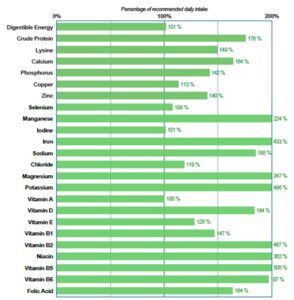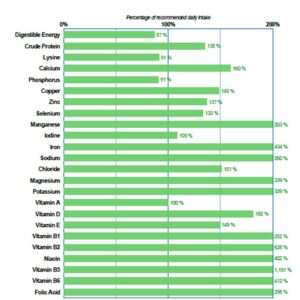Feeding through the seasons
As grazing animals that are predominantly managed with some level of pasture intake or with complete access to pasture, it is important to consider how changes to pasture quality and quantity through the changes of season can and should affect how horses are managed and fed. As pasture availability changes, generally an automatic response of owners is to increase or decrease the amount of hay and supplementary feed being fed. While this is the right response to manage a horse’s weight and body condition, ensuring horses are obtaining all the nutrients they require through the changes of season is not as simple as increasing or decreasing the amount of hay or feed in their diet. This article will cover how you can correctly adjust your horse’s diet through the changes of season without compromising on any nutrients they require.
Energy:
Dietary carbohydrates are the major source of energy within horse’s diets. Providing majority of the fuel for everyday maintenance and functioning of the body, as well as the fuel required for exercise, reproduction and growth. The main sources of dietary carbohydrates within the equine diet are forage, grain, and grain by products. Grasses, hays, and any form of forage contain both non-structural carbohydrates (NSC’s) (starch and fructan) and structural carbohydrates (hemicelluloses, cellulose, and lignocellulose) that are available for digestion. Structural carbohydrates are the most important energy source within the horse’s diet, providing anywhere from 50-100% of energy intake. Cellulose is the most abundant carbohydrate in most forages and is the largest contributor to energy produced from microbial fermentation. When the amount and quality of pasture increases in seasons of high rainfall, the amount of energy that horses are able obtain from pasture alone increases drastically and can be enough to sustain a lactating mare, a growing horse, or a high-level performance horse. While in winter or seasons of drought, pasture availability can rapidly decrease, and supplementary hay and feed is required to provide an adequate amount of digestible energy to maintain weight. Managing horses’ weight and body condition through changes of season can be as simple as increasing and decreasing the amount of feed provided based on the amount of pasture that is available; with the exception of extreme cases of emaciation or obesity where careful management is required. While this is true for energy, the same is not true for protein, mineral and vitamin intake.
Protein:
Protein is a major component of most tissues within the body, second only to water. Protein consumed in the diet is composed of chains of amino acids, during digestion the body ‘cuts up’ protein into these amino acids so they are able to be absorbed and synthesized into proteins that the body needs. Amino acids can be put into two categories: non-essential and essential. Non-essential amino acids can be synthesized by the body and don’t need to be present in the diet, while essential amino acids can not be synthesized by the body and so the horse needs to obtain this from their diet. There are 9 presumed essential amino acids, including lysine, methionine, and threonine. The amount of protein a horse requires in their diet will vary depending on their production state and workload. Horses at maintenance (not growing or in work) have the lowest requirements for protein at an estimated 550g CP/day for a 500kg horse, while horses in heavy work and lactating mares have the highest protein requirements at an estimated 1000g CP/day and 1500g CP/day for 500kg horses, respectively. Variations in pasture quality will also influence a horses protein intake. A horse at maintenance on good quality pasture will likely obtain enough protein in their diet from pasture alone. While a lactating mare or high-performance horse with higher requirements of protein, specifically essential amino acids such as Lysine, are likely to not obtain this from good quality pasture alone. While pasture may provide enough energy to maintain weight, lactation, and energy for performance without the provision of supplementary feed, essential amino acid intake may be lacking.

Vitamins and Minerals:
While vitamins and minerals comprise only a minor part of the diet by weight, they play a major role in the overall health of horses, including roles in maintaining acid-base balance, formation of structural components, enzymatic co-factors, and energy transfer. When pasture is abundant and supplementary feed is reduced or removed, in almost every case a deficiency of minerals will appear. In Australia the most common minerals lacking in pasture are copper, zinc and iodine and these deficiencies will arise even for horses at maintenance. For horses with higher requirements of minerals and vitamins such as lactating mares, growing horses and horses in work often calcium, phosphorus, selenium, and vitamin B1 will also be deficient.

Balancing energy intake while ensuring adequate nutrient intake
Quality supplementary ‘full’ feeds are fortified with essential amino acids, minerals, and vitamins and when fed at the recommended feeding rates, each of these requirements are often met. In dry periods when horses are on poor pasture often supplementary feed needs to be fed to meet digestible energy requirements. For example, here is a diet of a horse in moderate work, who through a dry period was on low quality pasture, supplemented with lucerne hay and 3.2kg of EasiResponse. The 3.2kg of EasiResponse is required to meet the energy requirements for performance, that is not being provided by pasture and is also working to meet vitamin and mineral requirements.

When pasture quality improves, if the same amount of hay and supplementary feed is provided this will result in excessive weight gain and likely too much energy when ridden. In response to an increased amount of pasture the hay is removed and the amount of EasiResponse is decreased to 1kg. While this effectively reduces digestible energy intake, it leaves the diet deficient in copper, selenium, and iodine.

While the amount of EasiResponse could be increased to meet these requirements, the use of Pryde’s Sliding Scale is an ideal option. The Pryde’s Balancer Range is designed specifically to meet horses’ requirements through the changing of seasons. For the horse in moderate work, as the amount of a full feed such as the EasiResponse is reduced due to increased pasture availability, a balancer pellet can be introduced to fill the nutrient gaps that this creates. Here’s the same diet, with 500g of the Essentials 150 introduced.

The introduction of the Essentials 150, ensures that the minerals that were deficient are now being met, notice also that the use of this doesn’t increase digestible energy intake. In the case where pasture quality improves further, the EasiResponse could be completely removed, and the Essentials 150 used alone. Below is an example of how the two can work together to moderate energy intake with changing pasture quality, while meeting all nutrient requirements, for a 500kg horse in moderate work:
| Pasture Quality | Poor | Average | Good | Excellent |
| EasiResponse | 3.5kg | 2.5kg | 1kg | 0kg |
| Essentials 150 | 0kg | 0kg | 0.5kg | 0.8kg |
In the case of the lactating mare that was deficient in lysine as well as the above minerals, the addition of a balancer pellet that contains high quality protein and the correct amounts of vitamins and minerals is ideal, rather than the inclusion of a vitamin and mineral supplement or mineral block. Here is the same mare, with the addition of 1kg of Lush 200.

The addition of the Lush 200, not only fills the nutrient gaps, it also meets the mare’s lysine requirements. Similarly, to EasiResponse and Essentials 150, BioMare Cubes and Lush 200 can also be used in conjunction to moderate energy intake with changing pasture quality, while meeting all nutrient requirements.
| Pasture Quality | Poor | Average | Good | Excellent |
| BioMare Cubes | 4-5kg | 3-4kg | 1-2kg | 0kg |
| Lush 200 | 0kg | 0kg | 400-700g | 1kg |
To take the guess work of balancing energy intake with vitamin and mineral intake, each of the Pryde’s full feeds have a ‘Keep it Balanced’ section, which can be found on the back of the bags or on the website. This provides you with the recommended amount of a balancer pellet to add into your horse’s diet for every 1kg under the recommended feeding rate being fed. There are a range of balancer pellets available, depending on your horse’s individual requirements. For example, the use of High Cal is recommended when horses are grazing high oxalate, subtropical pastures or Premium 250 if horses in moderate-heavy work are grazing native pastures, that contain lower amounts of protein. You can find more information about them by clicking below:
While it may seem overwhelming at first to ensure your horse is obtaining all their nutrient requirements while moderating their energy intake especially when there is abundant pasture; the range of Pryde’s products are carefully formulated to ensure these requirements are met to give you peace of mind and to take the guess work out of feeding. If you would like to know more about how the Pryde’s products work together to promote optimal health and performance in your horse, please get in contact or use our free feed selector.




